Key Insights
- Transaction volume saw an increase for the sixth consecutive quarter, achieving a new record of 164 million daily average transactions. The Hedera Consensus Service is responsible for 99% of all transactions on the network.
- HBAR’s circulating market cap increased 78% QoQ to $2.9 billion, outpacing the overall crypto market’s growth of 54%. This Q4 growth brought HBAR’s YoY change to 211%.
- Hedera’s Total Value Locked was $64 million. SaucerSwap’s TVL grew from $27 million to $60 million (+123% QoQ) and accounted for 95% of the network’s total TVL.
- The Hedera Council has allocated 4.86 billion HBARs ($400 million) to enhance the Hedera network. This investment is intended to support various projects and initiatives within the Hedera ecosystem, promoting further development and adoption.
- Hedera continues to heavily invest in its EVM capabilities. Notable releases include the JSON-RPC codebase, Metamask support, integration with Validation Cloud, the Stablecoin Studio toolkit, and the introduction of HIP-729 to refine contract creation.
Primer
Hedera (HBAR) is an open-source, public-permissioned Proof-of-Stake (PoS) blockchain network. It is governed by 30 global organizations, known as the Hedera Council, with input on the network’s features and ecosystem standards from the community via Hedera Improvement Proposals (HIPs). Members of the Council operate Hedera’s validator nodes while the network transitions to fully permissionless node operation. Although Hedera’s Network operation is currently permissioned in nature, the division of responsibility across each of the 30 geographically and industry-diversified (collusion-proof) council members is unique among public DLTs.
The Hedera Network offers an optimized version of the Besu EVM for smart contracts (Hedera Smart Contract Service), alongside a native tokenization service (Hedera Token Service) and high-throughput data writing and verification service (Hedera Consensus Service). These services are known as the Hedera Network Services, which developers can use to build decentralized applications. The network is powered by the Hashgraph Consensus Algorithm, which delivers high throughput, fair ordering, and low-latency consensus for all transactions.
Website / X (Twitter) / Discord
Key Metrics
Financial Overview

Market Capitalization

In Q4 2023, the total crypto market cap experienced a sharp increase, largely driven by anticipation surrounding spot BTC ETFs. HBAR’s circulating market cap increased 78% QoQ to $2.9 billion, outpacing the overall crypto market’s growth of 54%. This Q4 growth brought HBAR’s YoY change to 211%. At the same time, HBAR’s fully diluted market cap rose 76% QoQ to $4.4 billion, up 133% YoY. HBAR’s market cap ranks in the mid-30s among all crypto projects.
Revenue

In Q4 2023, Hedera Network’s revenue, derived from network transaction fees, grew by 59% to $1.6 million. The growth was predominantly attributed to a 66% QoQ increase in transactions, driven by the Hedera Consensus Service. Additionally, despite representing a small fraction of total transactions, the Hedera Token and Smart Contract Services contributed approximately 14% of the total revenue. This revenue share from Token and Smart Contract Services can be attributed to their higher fixed costs compared to the Consensus Service. This signifies a healthier distribution in Hedera’s revenue streams.
Supply

HBAR, Hedera’s native token, serves multiple purposes within the network. It is utilized for paying network gas fees, paying Hedera Network Services fees, delegating to validators, and securing the network. In the future, the Hedera network will also enable staking for operating permissionless public validators and rewarding validators.
HBAR has a fixed total supply of 50 billion. As of the end of Q4, 33.6 billion HBAR, representing 67% of the total supply, was in circulation. The distribution of HBAR occurs quarterly and is reported through the Hedera Treasury Management Report. In Q1 2024, the Treasury Management Report forecasts that approximately another 10% of the HBAR total supply will be unlocked, which includes the new ecosystem grants.
Network Overview

Usage

In Q4 2023, the Hedera network witnessed a decline in addresses, as average daily active addresses decreased by 22% QoQ to 6,600, and average daily new addresses dropped by 39% QoQ to 5,200. Addresses peaked during Q2 2023, attributed to events hosted by the Karate Combat DAO, but have declined in the two subsequent quarters. Nevertheless, the network still maintains YoY growth, with active addresses up 90% YoY and new addresses up 123% YoY.

During Q4, the Hedera network’s transaction volume saw an increase for the sixth consecutive quarter, achieving a new record of 164 million daily average transactions (+66% QoQ). The Hedera Consensus Service remains the predominant source of this activity, responsible for 99% of all transactions on the network.
In Q4, there were several notable Hedera wallet-related announcements. The WalletConnect Working Group unveiled WalletConnect integrations, facilitating smoother interactions between wallets and protocols on the Hedera network. In a collaborative effort, Hedera and Algorand introduced a decentralized wallet recovery system and organization, the DeRec Alliance. Additionally, Tuum Technologies launched the Hedera Wallet Snap plugin, linking Hedera with MetaMask.
Development
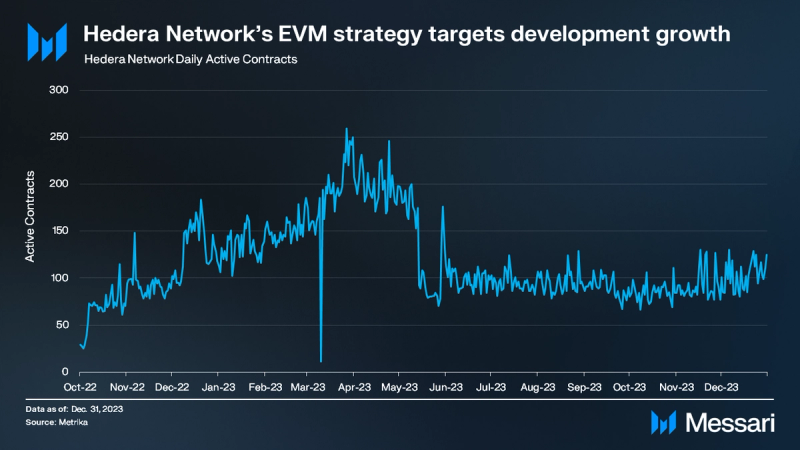
Hedera’s development activity remained consistent during the second half of 2023, with approximately 100 daily active smart contracts on the network. Throughout the year, Hedera introduced various developer-focused tools and products. In the third quarter, the community integrated the JSON-RPC codebase, allowing developers to use Ethereum Virtual Machine (EVM) tools. Additionally, HIP-729 was introduced, refining contract creation transactions to align more closely with EVM equivalence.
In the fourth quarter, Hedera made additional announcements, including the deprecation of the hethers.js library as the network’s increasing EVM equivalence made it redundant. Hedera also released the NFT Utilities SDK for JavaScript, facilitating NFT-related software development by providing tools for metadata validation, risk assessment, and rarity score calculation. Additionally, the Hashgraph Application Studio by Joget Inc., introduced generative AI features which simplifies protocol creation and increases efficiency. Furthermore, Hedera optimized its core algorithms, enhancing the consensus process through the ‘Optimized Other-Parent Selection’ algorithm.
Swirlds Labs and the HBAR Foundation organized the Beyond Blockchain Hackathon 2023 to showcase projects addressing real-world issues. Additionally, the Africa Money and DeFi Summit highlighted Hedera’s potential in bridging the financial access gap in Africa.
Decentralization and Security

In Q1 2023, Dell Technologies joined as the 28th member, and in the second quarter, COFRA joined as the 29th member. Further expanding the council’s diverse representation, Hitachi America, Ltd. joined as the 30th member in the first quarter of 2024.
As Hedera’s network expands, the Council anticipates more public nodes to bolster its infrastructure. Council members serve three-year terms, limited to two consecutive terms, and possess equal voting rights on network and platform decisions. Swirlds, the creator of Hashgraph, maintains a permanent Council seat but has an equal vote in decision making and lacks additional privileges.
The Council primarily focuses on governance for network stability and Hedera Treasury management through various committees:
- TechCom: Oversees and provides insights on the Hedera Network’s technological functionality, stability, and security.
- MemCom: Guides strategic decisions concerning Council membership, encompassing recruitment, selection methods, policies, and retention.
- CoinCom: Counsels the Council on treasury management, network pricing, and economic incentive structures, encompassing staking and node operations.
- CorpCom: Aids Members in identifying Hedera Network use cases and orchestrates Council-wide collaboration on market entry strategies.
- GovCom: Addresses public policy and regulatory matters impacting the Hedera Network, Council operations, or Member interactions with the network.
- MarCom: Supervises and advises the Council on marketing, public relations, and outreach initiatives.
During the third quarter, Hedera Hashgraph, LLC’s Board of Directors approved Andrew Aitken as the Chief Open Source Officer and made a strategic decision to bifurcate the roles of Chair and President. Brett McDowell, who holds both titles, was reappointed to serve as Chair for an extended two-year term. In the fourth quarter, Charles Adkins, who previously held roles at Aptos and Polygon Labs, took on the role of President of the Hedera Council.
The Hedera Council has allocated 4.86 billion HBARs ($400 million) to enhance the Hedera network. A substantial portion, 4.25 billion HBAR, is allocated to grant and support giving organizations such as the HBAR Foundation, Hashgraph Association, and DLT Science Foundation, with planned distributions in Q1 and over the course of the year. The remaining 614.06 million HBARs are earmarked for the Hedera Council’s operational costs and payments to initial SAFT investors.

Hedera Network consensus nodes are run by the Governing Council members. Of the 30 council members operating consensus nodes, there are 27 service providers (93%).
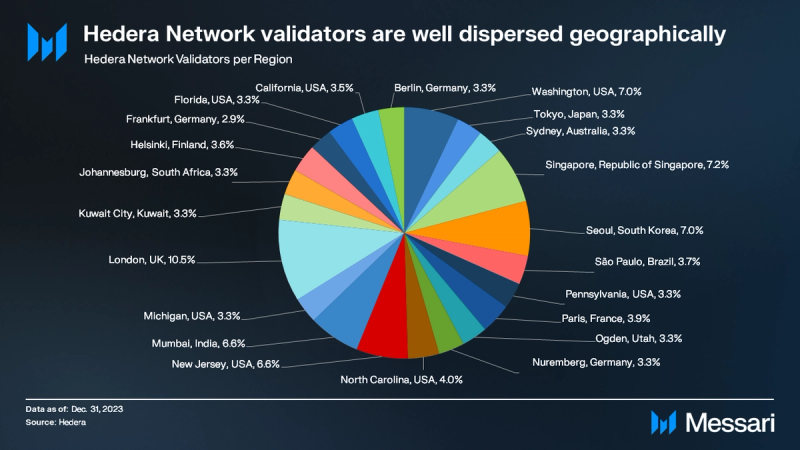
The geographical distribution of the Hedera network’s validators is also balanced, and includes every continent except Antarctica. North America is home to 10 of the 29 consensus nodes, accounting for 34.48%. Both Asia and Europe have eight consensus nodes each, each constituting 27.59% of the total.
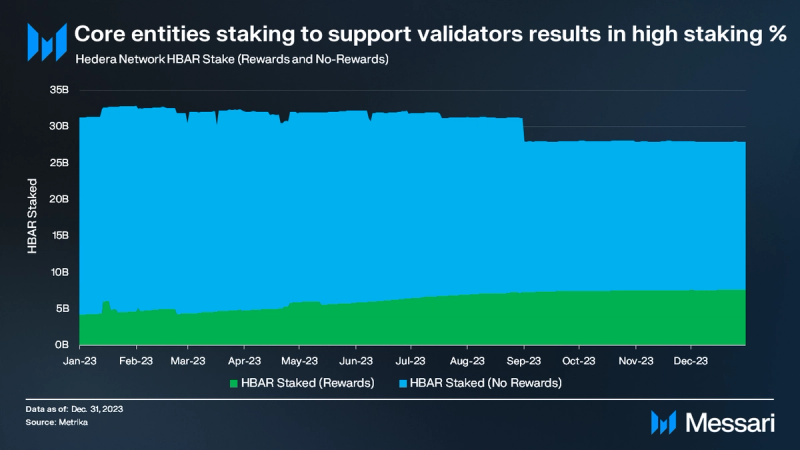
In Q4 2023, the Hedera network reported 28 billion HBAR staked, which represents 85% of the circulating supply and 56% of the total supply. This high staking percentage relative to the circulating supply can be attributed to entities such as Swirlds, and Swirlds Labs. They are staking their HBAR allocations and the Hedera Treasury to assist validators in meeting the minimum staking threshold to participate in network consensus. Notably, these entities have chosen not to collect staking rewards.
Only 26% of staked HBAR opted to receive rewards. During Q3, the Hedera Council made modifications to the staking rewards structure. The prior staking reward rate of 6.5% was adjusted to 2.5% in August. Furthermore, the highest quantity of coins that can be staked and qualify for the full 2.5% reward rate is set at 13% of the total 50B HBAR supply, which is equivalent to 6.5B HBAR. Should the total staked amount exceed 13% of the overall supply, the reward rate will proportionally decrease.
Ecosystem Overview

DeFi

In Q4 2023, the Hedera network’s Total Value Locked (TVL) continued its positive trajectory, concluding the year with a TVL of $64 million (+169% YoY). Additionally, the TVL denominated in HBAR reached 733 million, reflecting an increase of 16% both QoQ and YoY. By the end of Q4, the Hedera network ranked top 40 by TVL among blockchain networks.

In Q4 2023, SaucerSwap further solidified its dominance within the Hedera network ecosystem, increasing its TVL from $27 million to $60 million (+123% QoQ) and accounting for 95% of the network’s total TVL. SaucerSwap’s launch of SaucerSwap V2 in November brought new features and improvements, including concentrated liquidity, MetaMask support, and Tokenomics V2. Additionally, DaVinciGraph, a token management suite, launched in Q4 and ended the quarter with a TVL of $310,000. The other two leading protocols were HeliSwap, with a TVL of $3 million (-23% QoQ), and Pangolin, with a TVL of $187,000 (+74% QoQ).
DeFi Diversity measures the number of protocols that constitute the top 90% of DeFi TVL. A greater distribution of TVL across protocols reduces the risk of widespread ecosystem contagion resulting from adverse events like exploits or protocol migrations. The Hedera network ended Q4 with a DeFi diversity at 1.

Liquid staking is not included in the TVL figure. Despite this, it remains a relevant metric with growing significance. Stader is the only provider of liquid staking on the Hedera network. Upon the introduction of the Hedera network’s staking program, Stader’s TVL reached its highest in Q1 2023. Following this peak, there was a gradual decline in Stader’s TVL before it jumped 57% QoQ in Q4 2023, ending the year with a TVL of $33 million.

In the fourth quarter, the Hedera network’s average daily DEX trading volume was $1.3 million, a 164% increase from the previous quarter and an all-time high. In alignment with the TVL distribution, SaucerSwap dominates DEX trading volume on the Hedera network, accounting for nearly all of the activity.

In the fourth quarter, the Hedera network’s stablecoin market cap increased by 73% QoQ, reaching a year-end total of $6.3 million. USDC stands as the only stablecoin available on Hedera. As of the end of Q4, the Hedera network was ranked approximately 46th in stablecoin coin market cap among blockchain networks, up four spots QoQ.
The third quarter saw significant developments in the Hedera stablecoin sector. Shinhan Bank, SCB TechX, and a major Taiwan-based financial institution successfully completed a stablecoin remittance proof-of-concept pilot on the Hedera network. The PoC achieved real-time settlement and foreign exchange rate integration for Thai Baht, New Taiwan dollar, and South Korean won. In addition, Hedera developers, alongside Swirlds Labs, The HBAR Foundation, and ioBuilders, introduced the Stablecoin Studio, an open-source SDK designed to simplify stablecoin issuance and management. The SDK offers a set of tools that assist organizations in launching and maintaining applications integrated with stablecoins.
Additionally, Fresh Supply Co (FSCO), which migrated to Hedera from the private Mastercard Provenance (MP) blockchain, announced that it had integrated Hedera into its Continuity payment trigger API. Through the Continuity API, Hedera can now connect to ACH (bank-to-bank payments), the Mastercard network, and soon the Mastercard Payment Gateway Services (MPGS) that focuses on serving online use cases like e-commerce, as well as other forthcoming Mastercard Web3 and digital asset products.
NFTs and Gaming
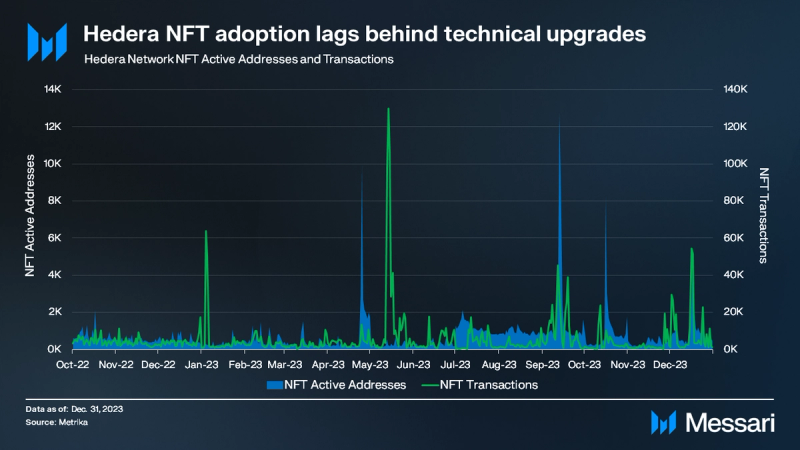
The Hedera NFT sector witnessed significant technical updates during the second half of 2023. Notably, in the third quarter, the Hedera Governing Council revised the fee structure for NFT minting, which was introduced with the v0.41 upgrade. This adjustment reduced the cost for minting an individual NFT to $0.02 from $0.05, while the cost for bulk minting 10,000 NFTs increased to $200 from $76.80. Subsequent upgrades, v0.43 and v0.44, further expanded the capabilities by increasing the maximum allowable NFT mints and implementing NFT allowance checks on auto-creation.
Additionally, the Hedera NFT ecosystem saw a series of partnership announcements. In Q3, the HBAR Foundation revealed its partnership with the game Legends of the Past, developed by former Ubisoft, Supercell, and Tap4Fun employees. In August, Calaxy, a social application backed by NBA player Spencer Dinwiddy, launched and featured creators like Luis Suarez, Logan Chitwood, and Mickie James. Moving into Q4, XP.NETWORK connected Hedera’s NFT ecosystem to over 30 blockchains, including Ethereum, Polygon, and Solana. Furthermore, two music platforms, Amplify and Tune.FM, announced their involvement with Hedera.
Despite these developments, Hedera NFT activity has yet to fully reflect the technical upgrades and partnerships. In Q4, the network averaged 800 daily active addresses and 5,000 daily transactions, representing a decline of 42% and 14%, respectively, from the previous quarter.
ESG
Hedera places a strong emphasis on ESG alignment and has released multiple notable partnerships and announcements over the second half of 2023, including:
- In August, Hyundai Motor Company and Kia Corporation introduced an AI-enabled, blockchain-based Supplier CO2 Emission Monitoring System (SCEMS) to manage carbon emissions of business partners, utilizing the Hedera Network. Hyundai and Kia aim to preemptively meet environmental regulations and establish sustainable supply chains.
- In September, ServiceNow launched the ServiceNow ESG ReFi application, integrating with the Hedera Guardian open-source tokenization engine. It uses the Hedera Network to track climate assets and individual token provenance.
- Also in September, ALLCOT IO onboarded ALLCOT’s 500 million metric tonne portfolio of carbon credits to the Hedera Guardian ecosystem, enabling Digital Measurement, Verification & Reporting (dMRV) of climate assets.
- EDF, REDEX, and Rekursive Labs collaborated on a proof-of-concept using Hedera’s technology to automate renewable energy certificate (REC) transactions, aiming to enhance efficiency and transparency in the renewable energy market.
- HYPHEN, a Swiss climate tech company, joined the Hedera Guardian ecosystem to improve carbon credit verification in Indonesia, utilizing real-time atmospheric greenhouse gas measurements and AI/ML models.
- At COP28, Envision Blockchain, HBAR Foundation, and Swirlds Labs introduced a digital platform for carbon markets, featuring a digital measurement, reporting, and verification (dMRV) system built on HBAR Hedera Hashgraph to enhance transparency.
- Demia joined the Hedera ecosystem to enhance trust and transparency in carbon markets, streamlining operations, improving data security, and setting new standards for data management and market integrity.
Network Services Overview
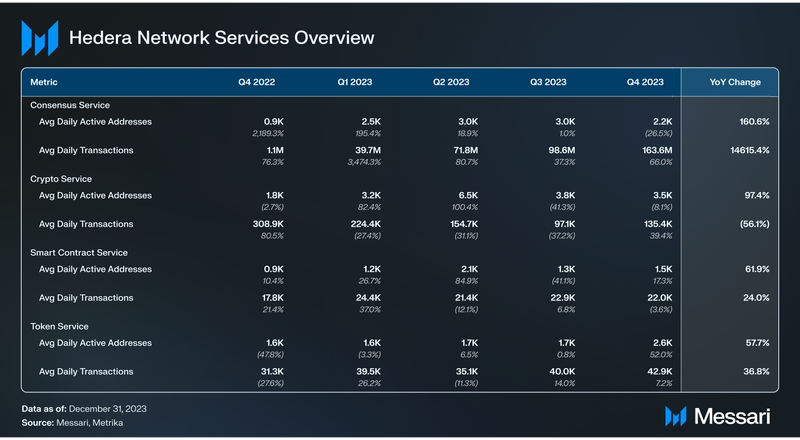
The Hedera Network Services are the core offerings of the Hedera network. These services include the Consensus Service, Smart Contract Service, and Token Service, all of which are supported by the Hashgraph algorithm and offer official SDKs for accessing the API in programming languages such as JavaScript, Java, Go, and Swift, and community SDKs supporting .NET and Venin SDK or JavaScript. Each service has its intended use and primary users, and usage frequency varies depending on the service.
Consensus Service

The Hedera Consensus Service enables the verifiable time-stamping and ordering of events for Web2 and Web3 applications. Users submit messages to the Hedera Network, where the messages are time-stamped and ordered by the Hashgraph algorithm. These messages are used to form an auditable history of verifiable and trustless events. The Consensus Service is utilized by various applications such as tracking supply chain provenance, logging asset transfers between blockchain networks, counting votes in a decentralized autonomous organization (DAO), monitoring Internet of Things (IoT) devices, and more.
In 2023, the Hedera Consensus Service witnessed substantial growth, with transactions steadily increasing to reach 160 million per day in Q4 2023, marking a 14,600% YoY growth. Active addresses also exhibited significant growth, showing a 160% YoY increase in Q4.
Additionally, Taekion’s TFS Lite platform, funded by U.S. government agencies, launched on Hedera. This platform enables secure, blockchain-based file storage, ensuring file integrity and privacy. The International Centre for Culinary Arts in Dubai announced they are using Hedera blockchain to become the first culinary school globally to issue blockchain-based certification.
Crypto Service

The Hedera Crypto Service plays a vital role in tracking the flow of HBAR throughout the ecosystem, making the asset more liquid and mobile. Users can perform essential operations on the Hedera Network through this service, including transferring HBAR, fungible, and non-fungible tokens, creating and updating accounts, clearing accounts, and approving account allowances.
In Q4 2023, the Hedera Crypto Service maintained a steady QoQ activity level. However, there was a notable exception on December 30 when transactions spiked to 2.6 million, primarily driven by a gaming project conducting a token minting test.
Smart Contract Service
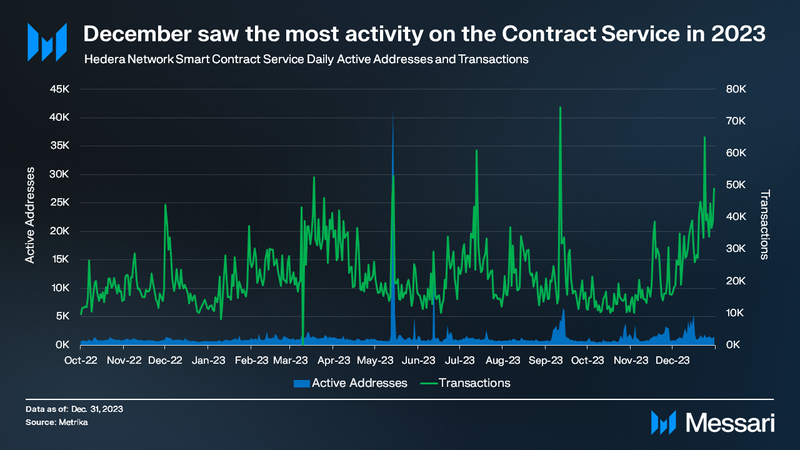
The Hedera Smart Contract Service enables developers to create and deploy smart contracts on Hedera. The service works with the Hedera Token Service to enable users to create and deploy fungible and non-fungible tokens. The service is also EVM-compatible via the HyperLedger Besu EVM client, providing support for Solidity-based smart contracts and core Ethereum tooling.
In Q3 2023, Hedera’s core developers implemented an update that revamped the authorization process. This change ensures that account key signatures no longer grant authorization for contract actions, limiting smart contracts to modifying only their own storage or that of delegate calls made to them. Additionally, the Hedera community unveiled developer-centric products and forged strategic partnerships with the goal of enhancing EVM tooling and compatibility.
In Q4 2023, Hedera core developers released two more important security updates for the Smart Contract Service. The first update, HSCS Security Model v2, enhanced security by refining authorization rules, introducing a three-level security approach, and addressing vulnerabilities. The second update was the introduction of Smart Contract Verification, aimed at enhancing trust among smart contract users. This feature enables the verification of smart contract source code, categorizing results as no match, partial match, or full match. Hedera hosts this service through Sourcify, ensuring accessibility at verify.hashscan.io and other Hedera blockchain explorers.
Token Service

The Hedera Token Service allows users to mint and manage custom fungible and non-fungible tokens on Hedera. Tokens issued on Hedera are also configurable with customizable parameters such as account KYC verification, freeze, token supply management, transfer, and more. Token transfers on Hedera always cost a transaction fee of $0.0001 USD, paid in HBAR.
In Q4 2023, the Hedera Token Service announced two significant partnerships. Firstly, Fresh Supply Co integrated HTS into its Continuity API, facilitating supply chain financing by incorporating tokenization into commercial workflows. Secondly, Archax and The HBAR Foundation expanded their partnership to support HBAR staking and institutional-grade tokenization. This expansion involved the integration of Hedera network and HTS support, allowing clients to earn yield on their HBAR assets through staking mechanisms. Overall, Hedera Token Service maintained consistent activity throughout 2023.
Closing Summary
The Hedera network closed a strong 2023 with its strongest quarter of the year. Transaction volume saw an increase for the sixth consecutive quarter, achieving a new record of 164 million daily average transactions. TVL doubled QoQ, ending the year at an all-time high of $64 million. HBAR’s circulating market cap benefited from the increased activity, increasing 78% QoQ to $2.9 billion, outpacing the overall crypto market’s growth of 54%. This Q4 growth brought HBAR’s YoY change to 211%.
Hedera also continued to invest in its future. Core developers released multiple EVM-related tools including the JSON-RPC codebase, Metamask support, integration with Validation Cloud, the Stablecoin Studio toolkit, and the introduction of HIP-729 to refine contract creation. The Hedera Council allocated 4.86 billion HBARs ($400 million) to enhance the Hedera network.
Looking ahead, Hedera remains well-positioned for further development and adoption, with a growing network, ongoing technical enhancements, and a commitment by the Council to the Hedera ecosystem.



















